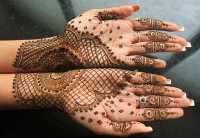
14 Jan Dermatologist Discusses Removal of Black Dye From Henna Tattoos
MedicalResearch.com Interview with:
Karan Lal, DO, Marketing Committee Member
for the Society for Pediatric Dermatology,
Dermatologist at UMass Memorial Medical Center.
Dr. Lal discusses the recent study of a procedure to remove black dye from henna tattoos.
MedicalResearch.com: What is the background for this study?
Response: Para‐phenylenediamine, a dye frequently added to henna tattoos to create the black color, is a potent contact allergen. Severe contact dermatitis may arise within days even after the first application. Our objective was to develop a method for rapid and complete removal of para‐phenylenediamine‐containing black henna tattoos from the skin, an important problem many physicians are confronted with, but for which no simple method exists.
MedicalResearch.com: Where else is PPD found, ie hair dyes?
Response: PPD, known formally as para-phenylenediamine is a black dye found in black textiles/clothes, rubbers, hair dyes, and in black henna(not organic henna) tattoos. This study was based on successful removal of another type of phenylenediamine with a commonly used solvent called PEG-400.
MedicalResearch.com: Would you describe the PPD removal procedure? Does it require medical supervision?
Response: The procedure is simple. Cotton balls soaked in PEG-400 were dabbed on the tattoo areas without rubbing. This was done for a number of cycles separated by 5 min tap water wash cycles. Henna tattoos last up to 3 weeks. PEG-400 is not a toxic chemical but because this has not been widely performed I would still want a healthcare provider to perform the procedure.
MedicalResearch.com: What should readers take away from your report?
Response: Readers should know that black henna tattoos pose a risk for contact dermatitis for children and adults and that patients can be sensitized from other agents that have PPD.
MedicalResearch.com: What recommendations do you have for future research as a result of this work?
Response: It is exciting to hear about a non-surgical means of tattoo removal in the event an allergic reaction occurs. I would like to see a larger case series of patients with different skin tones to see if there is any risk of dyspigmentation from treatment.
Citation:
Ferrari, DM, Hoffmann, JC, Schön, MP, Lippert, U. Efficient removal of black henna tattoos. Pediatr Dermatol. 2020; 37: 1063– 1067. https://doi.org/10.1111/pde.14349
[wysija_form id=”3″]
[last-modified]
The information on MedicalResearch.com is provided for educational purposes only, and is in no way intended to diagnose, cure, or treat any medical or other condition. Always seek the advice of your physician or other qualified health and ask your doctor any questions you may have regarding a medical condition. In addition to all other limitations and disclaimers in this agreement, service provider and its third party providers disclaim any liability or loss in connection with the content provided on this website.
Last Updated on January 14, 2021 by Marie Benz MD FAAD
